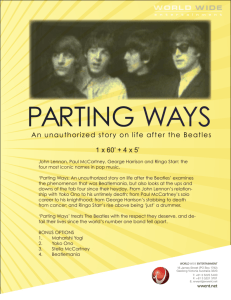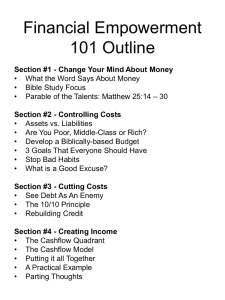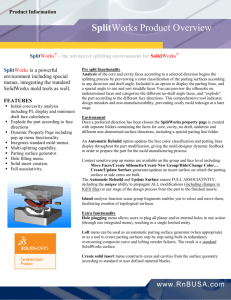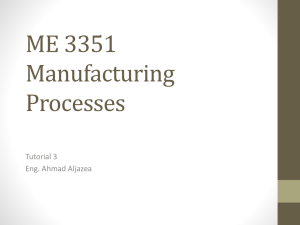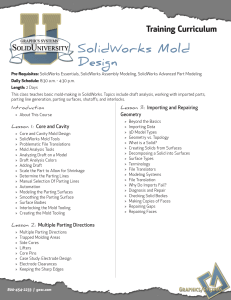Module 4b
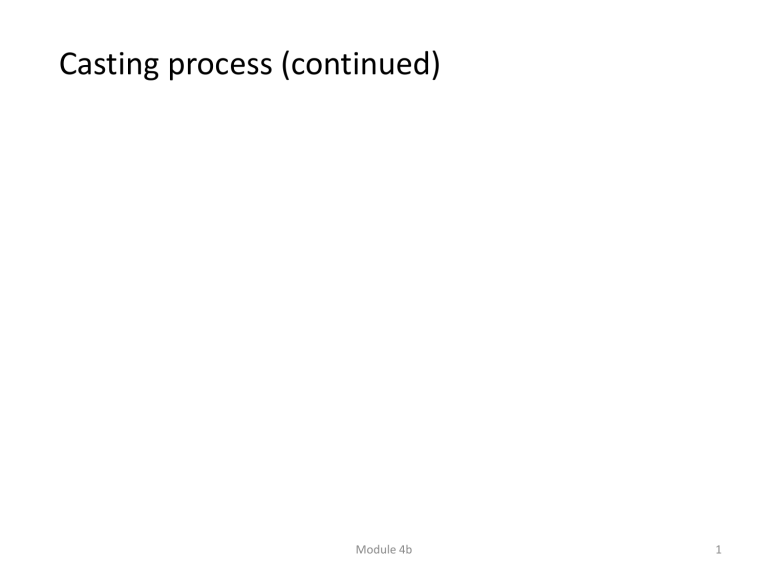
Casting process (continued)
Module 4b 1
Casting
Principle of the process
Process design : how to determine the process parameters so that the desired product can be manufactured and defects are eliminated as much as possible
Structure
Process modeling
Defects/quality control
Design and DFM
Process variation
Module 4a 2
Design of a casting process is to determine:
pattern, mold, sprue, gating system, mold cavity, riser parting line
pour temperature
Decision making on these issues
Process goal : Mold cavity is completely filled without defect
Process constraints : casting material, casting geometry, cost, time, quality
Module 4a 3
Process design – additional riser
Additional Riser
To control the shrinkage cavity to the riser
Module 4b 4
Process design – location of riser
Directional Solidification – Forced Solidification
Riser
(V/A)2 > (V/A)1
External and
Internal Chills
Module 4b 5
Process design – parting line or plane
Design for locating parting line – determine parting line or surface
Parting line or parting surface is the interface that separates the cope and drag halves of a mold, flask, or pattern and also the halves of a core in some core-making processes.
6
Process design – parting line or plane
Design for locating parting line – determine parting line or surface
Pulling direction
7
Process design – parting line or plane
Design for locating parting line – determine parting line or surface
Pulling direction
8
Process design – parting line or plane
Design for locating parting line – determine parting line or surface
Bad parting line
Best parting line
9
Process design
(a)
The main functional requirement for determining the parting line is: the pattern can be drawn out from the mold to leave a cavity. Besides, the selection of parting line can affect
1. Cores ( as little as possible)
2. Draft (as little as possible)
The core and draft cause material waste and extra steps in the casting process, which means cost increase.
(b)
(b) Is better as there is no need to have core and no need of draft; but
(a) needs core and draft.
Module 4b 10
Process design – parting line or plane
Parting line or surface determination
Parting line
Design features, such as round, may also put restriction to the location of parting line in the above cases
Module 4b 11
Casting
Principle of the process
Structure
Process modeling
Defects
Design and DFM
Process variation
Module 4b 12
Design and DFM
Original design
Module 4b
Modified design
13
Design and DFM
Design for Controlling the process
Module 4b 14
Design and DFM Intersection of two sections causes: hot spots (gap) and stress concentration shrinkage
Hot spots
Module 4b 15
Design and DFM
Fillet
Holes
Module 4b 16
Design and DFM
Avoid hot spots
Module 4b 17
Design and DFM
Pattern shrinkage allowance
Large casting, special rule: 1% - 5%
Solution to Cavity caused due to Shrinkage
Module 4b 18
Summary
Basic elements in the Casting Process
Mold
Mold
Materials
How Mold is made
How
Pattern is made
Module 4b 19
Summary
Permanent casting
Casting
Expandable casting
1. So far, expandable sand casting has been discussed. It is generic casting process except how pattern and mold are created .
2. How to make mold drives the invention of new casting processes.
Module 4b 20

